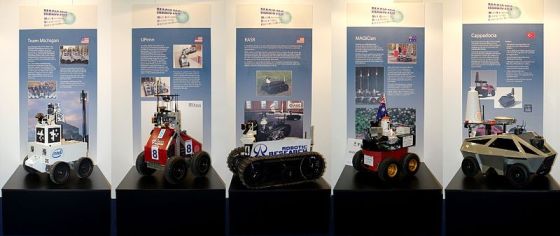As reported by the Australian Broadcasting Corporation, the Land Warfare Conference in Brisbane, looked like a scene of a cutting edge armoury being readied for battle. What with a cache of varied grenades, tanks and the latest devices used in the battleground of modern war. Also on display were fake eyeballs, limbs and injured bodies that pump fake blood through fake veins in order to help train soldiers in emergency first aid.
Also on display were gas-powered latches capable of knocking a reinforced steel door off its hinges, glass and metal plating that can withstand the force of an IED hit and the latest in combat clothing.
The show stealer however was the robot soldiers.
5,000 robots already exist on the ground in Afghanistan and Iraq and entrants in the MAGIC competition are tipped to be prototypes for the next generation of robots at war.
 Left to right: 1st Team Michigan,2nd U. Penn,3rd RASR,4th MAGICian WAMbot,4th Cappadocia
Left to right: 1st Team Michigan,2nd U. Penn,3rd RASR,4th MAGICian WAMbot,4th Cappadocia
Today, the winners of the Multi Autonomous Ground-robotics International Challenge (MAGIC) were announced at the conference. The competition is a joint initiative of the Australian and United States defence forces and attracted entries from all over the world.
The team led by Assistant Professor Edwin Olson from University of Michigan team, took away the $750,000 top prize.
Assistant Professor Olson says the group's robots work and communicate together as a team of 24.
"Our robots are small, but really capable, they have 3D lasers and they can build a 3D model of the world around them. They also have these 2D bar codes. That's one of the most obvious visual features of the robots which allows these robots to recognise each other and figure out where they are in relation to each other," he said.
The robots are designed to carry out urban reconnaissance and search and rescue missions.
Professor Olson told media that when used with high-powered radios these robots can be remote controlled from a few kilometres away.
"The idea is that the humans can be safely far away from the danger zone and the robots do all the low-level work to gather that information," he said.
Dr Malcolm O'Neill, the assistant secretary of the US Defence Force's Acquisition, Logistics and Technology division, says the robots and their inventors are pioneers.
Drones dominate the skies in many war zones and Dr O'Neill predicts robots playing a major role in land-based combat soon.
"I see in the future a US army with 547,000 active soldiers like we have today and 547,000 ranger buddies - wingmen that would hopefully go into combat with them and hopefully stand in front of them and sacrifice their robotic lives for the human who they're fighting with," he said.
Twenty-three teams from around the world entered the robot challenge, but the University of Michigan's team, along with two other US-based teams took out the top three positions. Australia's entry came in the top five.
The goal of the competition is to create multi-vehicle robotic teams that can execute an intelligence, surveillance and reconnaissance mission in a dynamic urban environment.